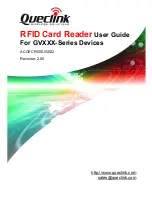
402-00005-00
Theory of Operation
2–38
Rev 02; February 8, 2002
RGB Video
VBLANK
HBLANK
Trigger
TRGCYC0
FIFO Load
TRGEN0
Strobe
Vsync
STRBDLY
No-strobe Region
Input
Figure 2–36. Triggered Acquire in Fast Strobe
2.7.7.7 Frame Reset Mode
In frame reset mode, the PWG is halted in vertical blank, waiting for an external trigger input. When the external
trigger occurs, the frame reset counter is loaded and counts off the number of lines programmed in the FROFF regis-
ter before starting the PWG counters. This extra delay count is only used for the first field of a frame reset cycle, and
allows for extra delay associated with a camera frame reset. Once the frame reset delay counts down, the PWG re-
sumes standard operation for one, two, or three fields based on the programmed mode of operation (Interlaced, non-
interlaced, and skip field mode). After the frame is acquired, the PWG again halts in vertical blank.
A frame reset pulse is output on the video connector, coincident with the external trigger, to asynchronously reset the
camera. The FRSTSZ bit selects the duration of the frame reset pulse as either one line or the number of lines pro-
grammed in the FROFF value. The polarity of the frame reset pulse is programmable. A strobe pulse (one line dura-
tion) is output when the PWG line counter reaches the STRBDLY count. After the extended vertical offset region
(VOFF+FROFF) count expires, the memory begins acquiring the programmed active region (frame or field depend-
ing on interlacing mode). The TRIGEN and TRIGCYC bits indicate the progress of the triggered acquire cycle.
The PTG (used in XTAL mode) is reset by the frame reset. This causes the vertical sync output of the PTG to be reset
coincident with the frame reset pulse output to the camera. Some cameras do not have a frame reset pulse input, but
Artisan Technology Group - Quality Instrumentation ... Guaranteed | (888) 88-SOURCE | www.artisantg.com
















































